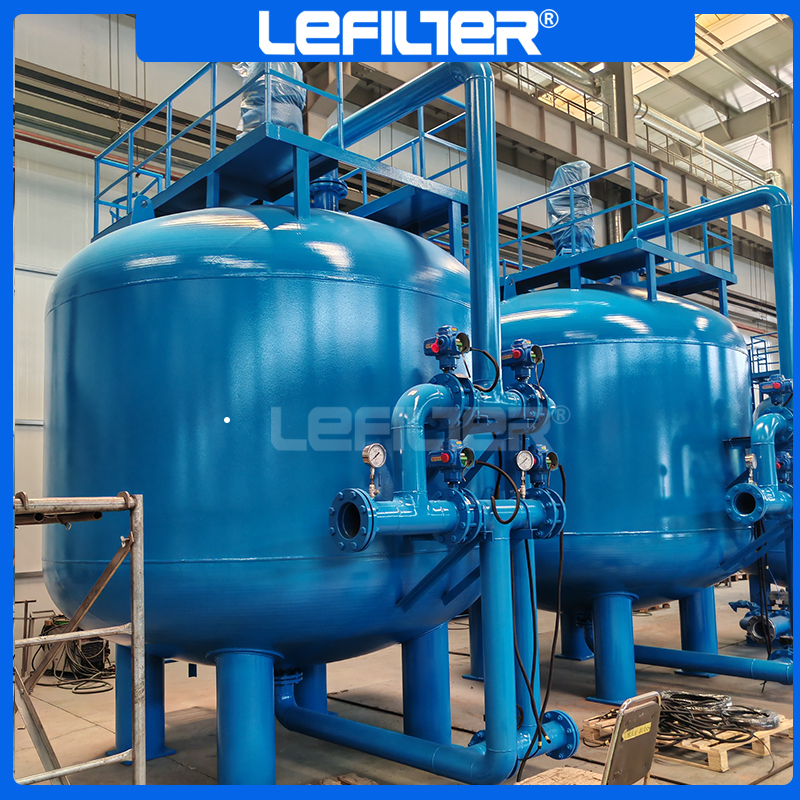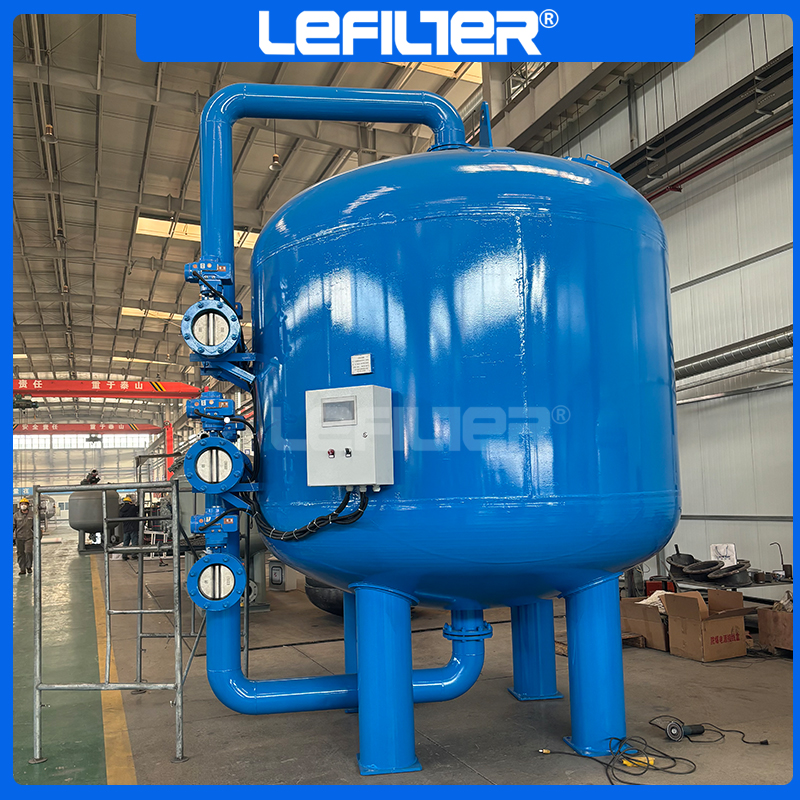Multimedia Filters in Wastewater Treatment Plants
DATE:2024-09-27 Number of views: 1 Source:dongwenhui
Multimedia filters are an essential component of wastewater treatment plants, playing a critical role in ensuring that treated water meets regulatory standards and is safe for discharge or reuse. These filters, which typically consist of layers of different media such as sand, gravel, and anthracite, effectively remove a wide range of contaminants from wastewater. We provide a detailed look at how multimedia filters function in wastewater treatment facilities and their importance in removing organic and inorganic pollutants.
Understanding Multimedia Filters
Multimedia filters operate on the principle of depth filtration, where water passes through multiple layers of media, each designed to capture specific types of particles and contaminants. The arrangement of these layers allows for a greater surface area and varied pore sizes, enhancing the overall filtration capacity. The primary functions of multimedia filters in wastewater treatment include the removal of suspended solids, organic matter, and certain inorganic contaminants.

Contaminants Typically Removed by Multimedia Filters
Multimedia filters are effective in removing a variety of contaminants from wastewater, including:
Suspended Solids: These are solid particles that can cause turbidity and hinder the clarity of water. Multimedia filters capture these particles through physical entrapment and straining mechanisms.
Organic Matter: This includes biodegradable materials such as food waste, sewage, and other organic pollutants. The removal of organic matter is crucial for reducing the biochemical oxygen demand (BOD) of the effluent.
Heavy Metals: Multimedia filters can effectively reduce the concentration of heavy metals like lead, copper, and zinc through adsorption and physical entrapment, although their effectiveness varies depending on the specific metal and filter configuration .
Nutrients: In some cases, multimedia filters can help in the removal of nutrients such as nitrogen and phosphorus, which are critical in preventing eutrophication in receiving waters.
Effectiveness in Removing Heavy Metals
The removal of heavy metals is one of the critical functions of multimedia filters in wastewater treatment. The effectiveness of these filters in capturing heavy metals largely depends on several factors:
Media Composition: The type and size of filter media play a significant role in determining the filter's capacity to adsorb and retain heavy metals. Media such as activated carbon or specific clays may enhance removal rates .
Water Chemistry: The pH, ionic strength, and presence of competing ions in the wastewater can influence the adsorption of heavy metals. For instance, lower pH levels can increase the solubility of certain metals, making them more challenging to remove .
Flow Rate: Higher flow rates may reduce contact time between the water and the filter media, which can diminish the effectiveness of heavy metal removal. Therefore, optimizing flow rates is crucial for achieving desired treatment outcomes.

Role in Tertiary Treatment Processes
Multimedia filters are often employed in the tertiary treatment phase of wastewater treatment plants, where the focus shifts to polishing the effluent before it is discharged or reused. In this stage, multimedia filters enhance the quality of treated water by removing remaining contaminants that conventional treatment processes may not have adequately addressed. This can include residual suspended solids, nutrients, and pathogens .
By providing an additional layer of filtration, multimedia filters help ensure that the effluent meets stringent regulatory standards, making it safe for discharge into natural water bodies or for applications such as irrigation and industrial reuse.
Effectiveness in Treating Industrial Wastewater
Multimedia filters can also be effectively used in treating industrial wastewater. Many industries generate wastewater with complex contaminant profiles, including oils, greases, heavy metals, and various chemicals. Multimedia filters can be tailored to address specific contaminant challenges based on the industry and the characteristics of the wastewater.
For example, in food processing industries, multimedia filters can efficiently remove organic matter and fats, while in metal finishing operations, they can be designed to target heavy metals and other toxic substances . However, it is essential to consider the specific composition of the industrial wastewater to optimize filter design and operation.

Innovations Improving Filter Performance
Recent advancements in filter technology have significantly improved the performance of multimedia filters in wastewater treatment:
Enhanced Media: The development of advanced filter media, including modified and functionalized materials, has led to improved contaminant removal efficiencies. These materials can provide greater surface area and better adsorption properties .
Automation and Monitoring: The integration of automation and real-time monitoring systems allows operators to optimize filter operation continuously. By tracking key performance indicators, such as pressure drop and flow rates, facilities can make timely adjustments to improve treatment efficiency .
Hybrid Systems: Combining multimedia filters with other treatment technologies, such as membrane filtration or biological treatment, can enhance overall treatment effectiveness. Hybrid systems allow for greater flexibility and adaptability to varying wastewater characteristics.
Water Chemistry and Filter Performance
The chemistry of the wastewater plays a significant role in the performance of multimedia filters. Parameters such as pH, temperature, and the presence of dissolved solids can affect the filtration process:
pH Levels: The pH of the water influences the solubility of contaminants and their interaction with the filter media. Maintaining optimal pH levels can enhance the removal of specific contaminants .
Temperature: Higher temperatures can increase the kinetics of chemical reactions and biological processes, potentially improving the effectiveness of contaminant removal .
Dissolved Solids: High concentrations of dissolved solids can lead to increased osmotic pressure, which may affect the filtration process and necessitate more frequent maintenance.

Decentralized Wastewater Systems
Multimedia filters can also be effectively utilized in decentralized wastewater treatment systems, which are gaining popularity in rural and remote areas. These systems offer a sustainable alternative to centralized treatment facilities and can be designed to treat domestic and light industrial wastewater .
In decentralized systems, multimedia filters can provide an efficient method for removing contaminants and ensuring that treated water meets local discharge standards. Their compact design and flexibility make them suitable for various applications, from individual homes to small communities.
Challenges in High-Chemical-Load Wastewater
One of the significant challenges associated with multimedia filters in wastewater treatment is the management of high-chemical-load wastewater. Industries such as petrochemicals and pharmaceuticals often produce wastewater with high concentrations of chemicals, which can lead to rapid fouling and decreased filter efficiency.
To address these challenges, operators must implement effective pretreatment processes to reduce the load on multimedia filters. Additionally, periodic maintenance and cleaning are essential to prevent the accumulation of contaminants and maintain optimal performance.
FAQ
1. What contaminants are typically removed by multimedia filters in wastewater treatment?
Multimedia filters effectively remove suspended solids, organic matter, heavy metals, and, in some cases, nutrients from wastewater.
2. How effective are multimedia filters in removing heavy metals?
The effectiveness varies based on media composition, water chemistry, and flow rates. Specific media types can enhance heavy metal removal rates.
3. What role do multimedia filters play in tertiary treatment processes?
In tertiary treatment, multimedia filters polish the effluent by removing residual contaminants to meet discharge or reuse standards.
4. Are multimedia filters effective in treating industrial wastewater?
Yes, they can be tailored to address specific contaminant profiles present in industrial wastewater, including oils, greases, and heavy metals.
5. What innovations have improved the performance of multimedia filters in wastewater treatment?
Advancements include enhanced filter media, automation, real-time monitoring, and hybrid treatment systems that combine different technologies.
6. How does water chemistry impact the performance of multimedia filters?
Parameters such as pH, temperature, and dissolved solids affect filtration efficiency, solubility of contaminants, and interactions with filter media.
7. Can multimedia filters be used in decentralized wastewater systems?
Yes, multimedia filters are suitable for decentralized systems, providing efficient treatment in rural and remote areas.
8. What are the challenges of using multimedia filters in high-chemical-load wastewater?
High chemical loads can lead to rapid fouling and decreased efficiency, necessitating effective pretreatment and regular maintenance to sustain performance.
Industry Solutions
Pure Water /Ultra Pure Water System


